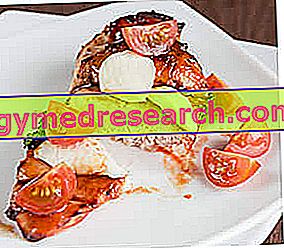Generality
Carne alla pizzaiola is the name used for a group of typical Italian recipes, prepared with two main ingredients: meat (veal, beef or pork) and tomato.

Overall, the meat in the pizza dish is a dish (second course) with a medium caloric intake, which depends mainly on the quantity of seasoning fats and the type of meat. It is also necessary to keep in mind that this recipe lends itself to an abundant use of bread (or potatoes, white rice, couscous, bulgur, etc.), an essential feature in assessing the caloric impact on the diet. Pizzaiola meat tomato can also be a sort of side dish, but some steamed or sautéed vegetables (especially sautéed pans) complete the recipe to perfection.
To get an idea of the nutritional profile of this dish, the chemical detail referred to a recipe with ingredients that are within the average compared to those likely to be used will be summarized below.
Nutritional Features
Meat Ingredients Pizzaiola style for 2-3 people: pork loin (lean meat) 300g, peeled tomatoes (pulp and juice) 200g, extra virgin olive oil 40g, fresh parsley 10g, garlic QB.
This recipe of meat with the pizzaiola brings a medium amount of energy, with a caloric prevalence of lipids on proteins (however abundant) and on carbohydrates.
The triglycerides of meat with the pizzaiola are those coming from the condiment fats used in cooking (in this case the extra virgin olive oil) and from the meat (in this case the pork loin); the fatty acids are mainly unsaturated, with a portion of monounsaturated that exceeds that of the saturated, of the polyunsaturated and the sum of both.
Carme alla Pizzaiola Nutritional Values with Pork Loin | |||||||||||||||||||||||||||||||||||||||||||||||||||||||||||||||||||||||||||||||||||||||||||||
 | |||||||||||||||||||||||||||||||||||||||||||||||||||||||||||||||||||||||||||||||||||||||||||||
| |||||||||||||||||||||||||||||||||||||||||||||||||||||||||||||||||||||||||||||||||||||||||||||
The peptides of meat with pizzaiola are predominantly of high biological value, as they derive from animal muscle tissue. This means that the amino acid pool of the recipe is complete, which is why it should comply with every protein requirement in the human body.
The carbohydrates are few, of the monosaccharide type (fructose), and coming from the ingredients of vegetable origin; fibers are also scarce.
The cholesterol contained in meat with pizza is quite moderate and does not represent a limit to the use of this recipe in the customary diet.
As far as the vitamin aspect is concerned, pizzaiola meat seems to boast discrete concentrations of the water-soluble thiamine (vit. B1) and niacin (vit. PP). Riboflavin (vit. B2) is not negligible, but neither is it very high; the ascorbic acid (vit. C), besides not being well present, undergoes a significant degradation with cooking. With regard to liposoluble, on the other hand, a fair concentration of retinol equivalents is appreciated (pro vit. A).
Analyzing the mineral profile, the pizzaiola meat contains only a fair portion of potassium, while the concentration of iron (normally high in meat, egg and fish dishes) seems disappointing; the amount of sodium is normally low, but the discretionary addition nullifies any attempt at estimation.
Pizzaiola meat is a recipe that lends itself to the vast majority of diets. It has no contraindications in diets for metabolic diseases such as: type 2 diabetes mellitus, hypertriglyceridemia, hypercholesterolemia (since, despite the presence of meat, the amount of cholesterol is moderate), hypertension and metabolic syndrome; in the case of overweight or obesity, it is necessary to reduce the portions to the lower limit from applicability.
From the hygienic point of view, the meat with the pizzaiola does not present any type of contraindication.
The average portion of meat with the pizzaiola is 150-250g (215-360kcal).
Meat alla Pizzaiola recipe
X Problems with video playback? Reload from YouTube Go to Video Page Go to Video Recipes Section Watch the video on youtubeVariables in the Recipe
Pizzaiola meat can be prepared in many ways. As anticipated, the muscle can be beef, veal or pork, although the most suitable one is beef. The desirable cuts are of various types: walnut, bell, loin, some parts of the shoulder, etc. Obviously, the choice also depends on the rest of the recipe, or rather on the preparation technique. For long cooking it is possible to use more tenacious pieces, with more connective and adipose tissue; on the contrary, for those rapids it is better to focus on lean and not very resistant types. In both cases, the meat must be cut into slices more or less thin and the thickness, for logic, subordinates to the length of the heat treatment.
Also for what concerns the tomato, the choice is rather wide. Commonly used ingredients include: passata, peeled, concentrated and fresh ripe tomatoes; the use of the latter is rare, but they offer an ideal alternative for quick cooking in hot seasons.
Now we come to garlic; whole or chopped, poached or naked, raw or cooked, is absolutely essential. In long cooking it is preferred whole, whether it is in shirt (removed after the aromatization of the oil) or naked (whole or in half) and left until the end of cooking; in this case, it is suitable for longer cooking times. On the contrary, chopped or squeezed, to be added raw at the end of cooking, it is exceptional in quick preparations and in hot seasons; obviously, it must be the chef's responsibility to remove the soul and make sufficient use of it, but not too abundant.
With regards to the spices to be used in the pizzaiola meat, an entire paragraph could be written; the most used odors are: oregano (fresh or dry), parsley (fresh) and basil (fresh); mint and marjoram are only relatively relevant alternatives. Never miss the spicy component, represented more often by black pepper and rarely by chili pepper. Even the spices must be added only at the end of cooking; parsley and basil characterize above all the quick cooking of summer recipes.
The dressing grease used for cooking should be extra virgin olive oil but, especially in longer cooking times and characterized by the use of concentrated tomato, someone uses butter.
Finally, since it is not always present, wine. This, strictly white and dry, is to be counted only in recipes that involve browning and blending the meat.
Below, we will briefly quote some methods to be used to cook meat with the pizzaiola:
- Brown the meat in the oil with the garlic, blend it and let the alcohol evaporate, add the tomato. Finish cooking by reaching the right density. Regular of spices and salt - very long duration
- Brown the meat in the oil, blend it and let the alcohol evaporate; aside, prepare a garlic tomato sauce and add it to the meat. Finish cooking by reaching the right density. Regular of spices and salt - long duration
- Prepare a garlic tomato sauce and, once it is thick, add the raw meat. As soon as the latter changes color, turn off the heat. Regular with spices and salt - short duration
- Brown the meat in the oil, blend it and let the alcohol evaporate; add diced tomato, let dry and season with salt and spices (minced raw garlic) - very short duration.
Obviously, the combination of all the variables can give rise to a multitude of recipes. Some variations also involve the use of cheese to be added at the end of cooking, directly in the pan but with the heat off. Suitable dairy products are: mozzarella with a low moisture content, fontina and emmentaler; some are satisfied with cheese slices or other melted cheeses.



